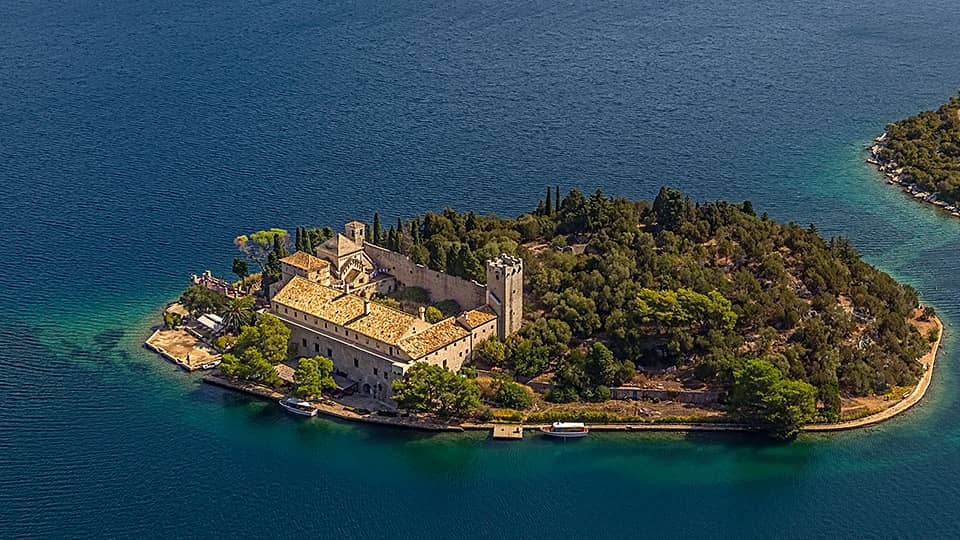The monastery with church was built on Island Mljet by the Benedictines of the Apullian Order in the 12th century.
In the second half of the 6th century the members of this order spread through Europe with the goal of preaching Christianity. The construction of Benedictine monasteries on the Adriatic coast covers the period from the 9th to the 12th century. At that time monasteries were built in Split, Zadar, Salona, Nin, Dubrovnik, Osor, Brač, Rab, on Krk...
Adventure Sailing 3-Night Trip from Dubrovnik including Mljet Island
Three-night sailing adventure from Dubrovnik exploring the less-frequented parts of the Dalmatian Coast around Dubrovnik.
This journey will take you to islands and pristine stretches of coastline that are often overlooked by tourists. After taking in the sights of Dubrovnik, board a boat and sail across the sparkling Adriatic Sea to visit charming Ston, with its impressive medieval walls and delicious oysters, the Elaphiti Islands, which are adorned with ancient villages, and the lush Mljet Island National Park.
Each day, you'll have the opportunity to engage in activities like kayaking, hiking, and exploring caves and coves. This small-group tour ensures that you receive personalised attention from the crew and guide, who will also provide insight into the history and culture of each location.
The package includes three nights of accommodation, a catamaran with an en suite bathroom, and three breakfasts.

Ferry connections to Mljet Island
Passenger ferry from Dubrovnik: Dubrovnik to Mljet, Korčula and Lastovo catamaran
Car ferry from Pelješac peninsula: Pelješac to Mljet car ferry
In accordance with general tendencies, a monastery was built on Mljet in the mid-12th century. Since the middle of the island was oriented, earlier on, to its northwest end, it was to remain so in the future. Benedictines from the monastery of St.Mary in Pulsano on Gargano were invited to Mljet by Desa, Duke of Zahumlje and Duklja, by issueing them a written pledge in 1151 that this lovely island was theirs.
The Benedictine monastery was re-built a number of times, and acquired the appearance of a Renaissance building, much like a summer residence. The architectural activity in the late 15th and 16th century that was flourishing in the Dubrovnik Republic did not bypass the monastery. The harmony of the Romanesque building had been altered by the Baroque. In 1949. when some repairs were made, segments of the original, Romanesque monastery were uncovered.
Now it is known that it stood southwest of the church, and that it lay north to south. Since the front face of the monastery used to stand directly over the sea's edge, Ignjat Đurđević wrote that the Benedictines used to toss their fishing lines out of the window, and fish from their cells.
In the second half of the 12th century, the Benedictines built the church of the Blessed Virgin Mary next to the monastery to meet the need for a place of worship. It was modeled after one that the Benedictines had used in their former residence, on Monte Gargano. In the 15th and 16th century the church was rebuilt and expanded. A defense tower was added.
In the period of the Renaissance the monastery and church were rebuilt with all the embellishments of Dubrovnik Gothic/Renaissance style. The monastery expanded and added tall towers as fortification measures. This may be when the well was built.
During the Baroque, the monastery was expanded once again and connected to the complete defense complex, which includes the church as well. A defense wall built with towers, and the wooded area and courtyard were landscaped. The only building to remain outside of the defense complex was the old mill. There are recordings that the passage through Solinski Channel was closed of with chains.
The monastery on the little island was connected to the mainland of the island by walls from both ends - clever Benedictines raised fish in the closed basin. The remains of the walls can be seen from the air. In the turbulent times, to defend itself against Turkish and pirate attacks, Benedictines reinforced the balconies and walls, and made windows smaller. The aesthetics had to suffer because of the struggle for safety.
One of the strangest curiosities on the island of St. Mary would be two marble columns at the jetty and in the church. Their origin is still a mystery, but probably date from the antique. Fragments of Roman brick have been unearthed on the island. The mysterious complex at the tip of the island hides a small building with traces of the vault and a narrow doorway.
The sea water colour in Great and Small Lake is amazing and there is a lot of shade to hide from sun in peak hours. There is bike rental so you could explore the area around the lakes and Mljet National Park by bike. If you plan to visit the Benedictine monastery on The Isle of Saint Mary be aware that entry in swimsuits is forbidden. Free ferry to the island is included in Mljet National Park entrance ticket.
Opening hours
open 09.00 - 18:00
Features
boat transport available, Take a swim in the lakes
Address & contact details
Street: Goveđari
Postcode: 20226
City: Island Mljet
Where to stay on Island Mljet
Our top picks for where to stay on Island Mljet.